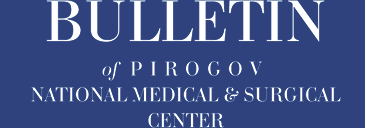Authors
Malishevskaya T.N.1, Kiseleva T.N.1, Renzyak E.V.2
1 Helmholtz National Medical Research Center of Eye Diseases, Moscow
2 Country clinical hospital, Khanty-Mansiisk
Abstract
Rationale. It is proved that the changes of ocular blood flow play an important role in the mechanism of primary open-angle glaucoma (POAG) development. The impact of occlusive-stenotic lesions of carotid arteries on POAG progression has been discussed in the course of the last ten years.
Objective: to study the characteristics of ocular blood flow and the changes of carotid arteries in patients with various stages of POAG.
Methods: 125 patients (210 eyes) with various stages of POAG, 65 eyes of them with early stage of POAG (1st group), 126 eyes with moderate stage (2nd group) and 19 eyes with advanced stage (3rd group) were examined. 20 healthy individuals (40 eyes) without ocular pathology and cardiovascular diseases constituted the control group. Ultrasound examination including Color Doppler imaging and pulse dopplerography were used for investigation of blood flow in ocular vessels in the retrobulbar region. The peak systolic velocity (PSV), end diastolic velocity (EDV) and resistance index (RI) were measured in the ophthalmic artery (OA), central retinal artery (CRA) and paraneural medial and lateral short posterior ciliary arteries (sPSA). According to the NASCET criteria, carotid stenosis is categorized.
Results: There was a statistically significant decrease of PSV, EDV in OA and the increase of RI in OA in eyes with advanced stage of POAG compared to control group and the 1st group (р<0,05). The results showed significant decrease of EDV and the increase of RI in CRA, medial and lateral sPSA compared to control and the 1st group that might indicate reduced retinal and choroidal blood flow. Ultrasound examination of carotid arteries showed critical stenosis of internal carotid artery (ICA) on ipsilateral side in 7,9% and 31,5% of cases in the 2nd and the 3rd groups, respectively. The mild stenosis of ICA was detected in the most cases (90,8%) of early POAG.
Conclusion: Ultrasound examination with the assessment of blood flow is noninvasive, available and high-informative method for the diagnostics of pathological changes of blood flow in ocular vessels in patients with POAG.
Early detection of impaired local blood flow and the pathology of carotid arteries in patients with glaucoma might contribute to determine the patient care management.
Keywords: primary open-angle glaucoma, ultrasound examination, color Doppler imaging, pulse dopplerography, blood flow, ocular vessels, internal carotid artery.
References
1. Flammer J, Orgül S, Costa VP, et al. The impact of ocular blood flow in glaucoma. Prog. Retin. Eye Res. 2002; 21: 359-393. doi: 10.1016/ s1350-9462(02)00008-3.
2. Petrov SYu, Kiseleva TN, Okhotsimskaya TD, Markelova OI. Eye microcirculation in glaucoma. Part 1. Diagnostic methods. Ophthalmology reports. 2024; 17(3): 113-123. (In Russ.) doi: 10.17816/OV628995.
3. Zarzecki M, Obuchowska I, Ustymowicz A, Konopińska J. Glaucoma Surgery and Ocular Blood Flow in Colour Doppler Imaging: Is There a Link? Clinical Ophthalmology. 2024; 18: 49-60. doi: 10.2147/OPTH.S441805.
4. Moskovchenko KP. On the development of glaucoma in patients with disturbed blood circulation in the carotid artery system. Vestn Oftalmol. 1966; 79(6): 48-51. (In Russ.)
5. Fedorov SN, Ivashina AI, Mikhailova GD. Matters of pathogenesis and treatment of glaucoma, 1981. Р.59-63. (In Russ.)
6. Zavgorodnyaya NG, Poplavskaya IA. Patologiya mozgovogo krovoobrashcheniya u bol’nykh pervichnoi glaukomoi i ee rol’ v razvitii patogeneticheskikh mekhanizmov zabolevaniya. M., 1999. Р.24-27. (In Russ.)
7. Marchenko LN, Fedulov AS, Rozhko YuI, Dalidovich AA, Rodina EV. Brachiocephalic hemodinamics in patients with open-angle glaucoma. Kuban Scientific Medical Bulletin. 2011; 1(124): 18-21. (In Russ.)
8. Kaiser HJ, Flammer J, Hendrickson Ph. Ocular blood flow. Basel: Karger, 1996.
9. Kiseleva TN, Grigor’eva EG, Tarasova LN. Glaucomatous neuropathy, combined with carotid disease: specificity of pathogenesis and diagnostics. Vestnik oftal’mologii. 2003; 119(6): 5-7. (In Russ.)
10. Vasontai Z, Mersich B, Gabor H. Carotid artery elasticity and baroreflex sensitivity in patients with glaucoma. Journal of Glaucoma. 2005; 14(1): 30-35. doi: 10.1097/01.ijg.0000145814.46848.76.
11. O’Brien C, Saxton V, Crick RP, Meire H. Doppler carotid artery studies in asymmetric glaucoma. Eye (Lond). 1992: 6(3): 273-6. doi: 10.1038/eye. 1992.51.
12. Gutman J, Melamed S, Ashkenazy J, Blumenthal M. Optic nerve compression by carotid arteries in low-tension glaucoma. Graefes. Arch. Clin. Exp.Opthalmol. 1993; 231(12): 711-717. doi: 10.1007/BF00919286.
13. Muller M, Kessler C, Wessel K, Mehdorn E, Kompf D. Low-tension glaucoma: a comparative study with retinal ischemic syndromes and anterior ischemic optic neuropathy Ophthal. Surg. 1993; 24(12): 835-838.
14. Choi J, Kook MS. Systemic and Ocular Hemodynamic Risk Factors in Glaucoma. Biomed Res Int. 2015: 141905. doi: 10.1155/2015/141905.
15. Neroev VV, Kiselevа TN. Ultrasound in Ophthalmology: A Guide for Physicians. M.: IKAR, 2019. (In Russ.)
16. Syrova ID, Kovalenko AV, Trubnikova OA, et al. Cerebrovascular complications in patients with moderate and small stenosis of the carotid arteries in the hospital period of coronary artery bypass grafting using cardiopulmonary bypass. Zhurnal nevrologii i psikhiatrii imeni S.S. Korsakova. 2022; 122(8): 73-79. (In Russ.) doi: 10.17116/jnevro202212208173.
17. Wu X, Konieczka K, Liu X, et al. The role of ocular blood flow in normal tension glaucoma. Adv Ophthalmol. Pract. Res. 2022; 2(1): 100036. doi: 10.1016/j.aopr.2022.100036.
18. Funk RO, Hodge DO, Kohli D, Roddy GW. Multiple Systemic Vascular Risk Factors Are Associated With Low-Tension Glaucoma.J. Glaucoma. 2022; 31: 15-22. doi: 10.1097/IJG.0000000000001964.
19. Banou L, Dastiridou A, Giannoukas A, Kouvelos G, Baros Ch, Androudi S. The Role of Color Doppler Imaging in the Diagnosis of Glaucoma: A Review of the Literature. Diagnostics. 2023; 13: 588. doi: 10.3390/diagnostics13040588.
20. Chou ChCh, Hsu MY, Lin ChH, et al. Risk of developing open-angle glaucoma in patients with carotid artery stenosis: A nationwide cohort study. 2018; 13(4): e0194533. doi: 10.1371/journal.pone.0194533.
21. Lin WYu, Wang JJ, Chen ChY, et al. The Relationship Between Carotid Artery Stenosis and the Development of Open-Angle Glaucoma: A Long-term Cohort Study in Taiwan. Ophthalmic Epidemiol. 2024: 1-9. doi: 10.1080/09286586.2024.2371467.


